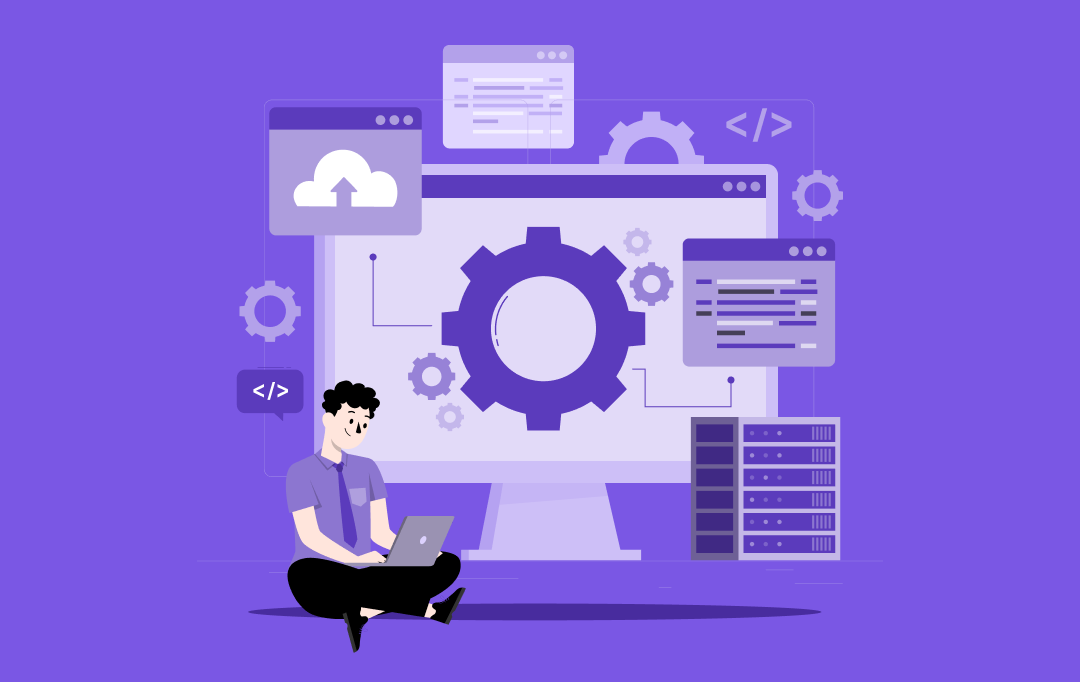Key takeaways:
- Outdated Governance: Traditional, rule-based governance is ineffective for today’s complex data ecosystems.
- AI as Augmentation: AI enhances, rather than replaces, human oversight by providing intelligence that can learn and adapt.
- Proactive Risk Management: It shifts compliance from reactive audits to predicting and managing risks before they materialize.
- Significant Market Growth: The data governance market is projected to reach $18.07 billion by 2032, growing at a CAGR of 18.9%.
- Strategic Implementation: Begin with a focused pilot in a high-value domain before expanding enterprise-wide.
- Future is Autonomous: The future lies in real-time autonomous systems, explainable AI (XAI), and integration with technologies like blockchain.
Enterprise data governance has traditionally been anchored in rules, roles, and reporting; however, this model is rapidly losing relevance.
With modern data ecosystems becoming increasingly complex, enterprises are grappling with fragmented data sources, multi-cloud environments, real-time data pipelines, and constantly evolving compliance requirements. In such environments, static governance frameworks—built around manual classifications, rigid taxonomies, and rule-based access controls—struggle to deliver the responsiveness and scalability required by today’s businesses.
This is where artificial intelligence is beginning to reshape the landscape.
- AI-driven data governance is not about replacing human oversight, but augmenting it with intelligence that learns, adapts, and scales.
- It brings automation to metadata discovery, context to data classification, predictive insight to risk management, and real-time adaptability to policy enforcement.
- For enterprises, this means fewer bottlenecks in analytics, faster onboarding of new data sources, improved data trustworthiness, and tighter alignment with data privacy and compliance frameworks, such as GDPR, HIPAA, and CCPA.
More importantly, AI enables governance to evolve from being a gatekeeping function to a business enabler. With intelligent governance, organisations can accelerate data access without compromising control, empower teams to self-serve while ensuring accountability, and build data ecosystems that are both agile and auditable.

According to Fortune Business Insights, the global data governance market size was valued at USD 4.44 billion in 2024. The market is projected to grow from USD 5.38 billion in 2025 to USD 18.07 billion by 2032, exhibiting a compound annual growth rate (CAGR) of 18.9% during the forecast period.
In this article, we explore how data governance for AI is revolutionizing across the enterprise landscape – and how to approach its implementation in a way that is secure, scalable, and business-aligned.
The Challenges of Traditional Data Governance
For years, enterprises have relied on policy-driven, manual frameworks to manage data quality, security, compliance, and lifecycle oversight. While these traditional data governance models served their purpose in structured, low-velocity environments, they’re proving increasingly ineffective in today’s data-intensive landscape.
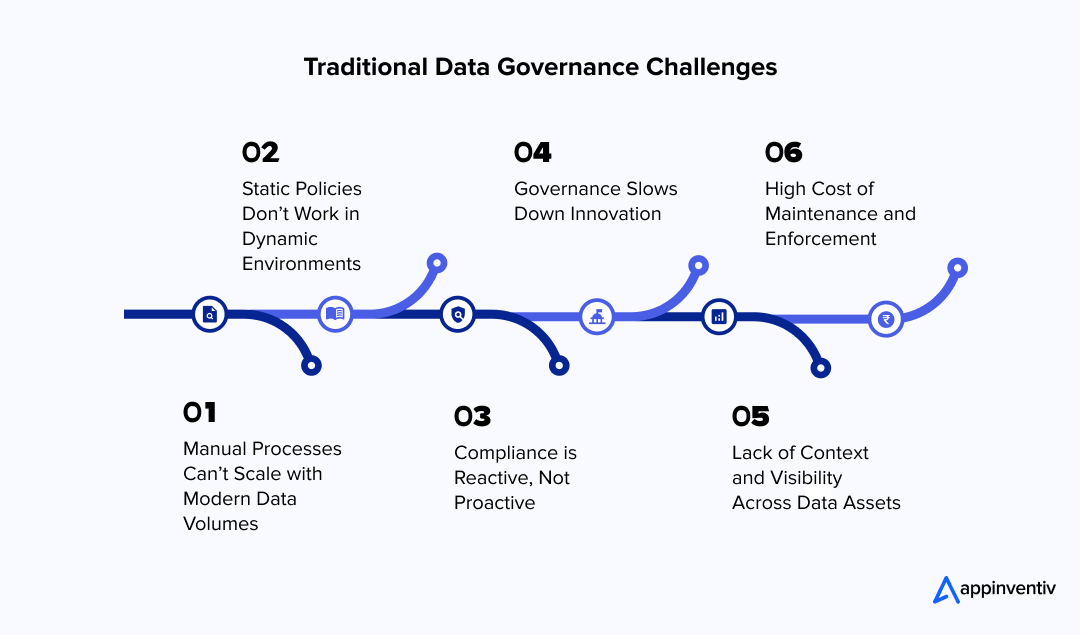
1. Manual Processes Can’t Scale with Modern Data Volumes
Data is no longer confined to relational databases inside on-premise systems. It now flows in from cloud apps, IoT devices, APIs, third-party platforms, and multi-region data lakes. Traditional governance teams are tasked with cataloging, classifying, and securing all this data using largely manual tools—often spreadsheets, isolated data catalogs, or policy documents.
The result? Incomplete metadata coverage, inconsistent standards, and governance frameworks that fail to evolve at the pace of business.
2. Static Policies Don’t Work in Dynamic Environments
Most legacy governance setups enforce policies that are rigid and predefined, applied uniformly across systems regardless of usage context, data sensitivity, or real-time risk factors.
In environments where user access needs can change daily, and data compliance requirements vary by geography, this static approach creates unnecessary delays and leaves room for human error. Updating or auditing policies can become an IT-heavy task, disconnected from the way data is consumed.
3. Compliance is Reactive, Not Proactive
With the growing number of IT compliance regulations, such as HIPAA, GDPR, and CCPA, as well as evolving industry-specific mandates, enterprises require governance systems that detect violations before they occur.
Traditional frameworks often depend on retrospective audits, periodic manual reviews, and user certifications to validate data controls. This makes it difficult to respond to compliance gaps in real-time or catch policy breaches as they unfold, exposing businesses to regulatory and reputational risks – something that the benefits of AI in data governance can easily mitigate.
4. Governance Slows Down Innovation
Rigid governance policies, particularly those related to access management and data provisioning, often slow down the time-to-insight. Business users, data scientists, and product teams are forced to wait days or weeks for approvals, access credentials, or data extracts.
Over time, this friction leads to shadow IT, decentralised reporting, or unsanctioned workarounds that further fragment data and erode trust.
5. Lack of Context and Visibility Across Data Assets
Traditional governance systems are limited in their ability to understand the full context around data – its origin, movement, transformations, usage patterns, or risk profile.
Without automated lineage tracking, semantic tagging, or real-time monitoring, it’s nearly impossible to answer key questions like: Who accessed this data? Has it been altered? Is it being used appropriately? This lack of visibility compromises both security and decision-making.
6. High Cost of Maintenance and Enforcement
Maintaining legacy governance tools and ensuring cross-departmental enforcement is resource-intensive. It often requires dedicated personnel to manage change control, data stewardship, issue resolution, and compliance documentation.
As governance requirements expand, so do the operational costs, without necessarily improving outcomes, pushing the enterprises towards the benefits of AI in data governance.
In today’s enterprise, data is not just an asset – it’s a moving target. Traditional governance models weren’t built to manage fluid, high-velocity data environments. AI-driven data governance offers a fundamentally different approach: one that’s dynamic, adaptive, and intelligent by design. It’s not just about efficiency – it’s about building a future-proof governance system.
Role of AI in Enterprise Data Governance
The benefits of AI in data governance can be studied by transforming it from a rigid, rule-based function into an intelligent, adaptive layer that scales with the enterprise. Instead of relying on static frameworks, businesses are looking for and embedding enterprise AI data governance solutions into the core of their data operations, enabling continuous, contextual governance that can handle modern data complexity across cloud, on-premises, and hybrid environments.
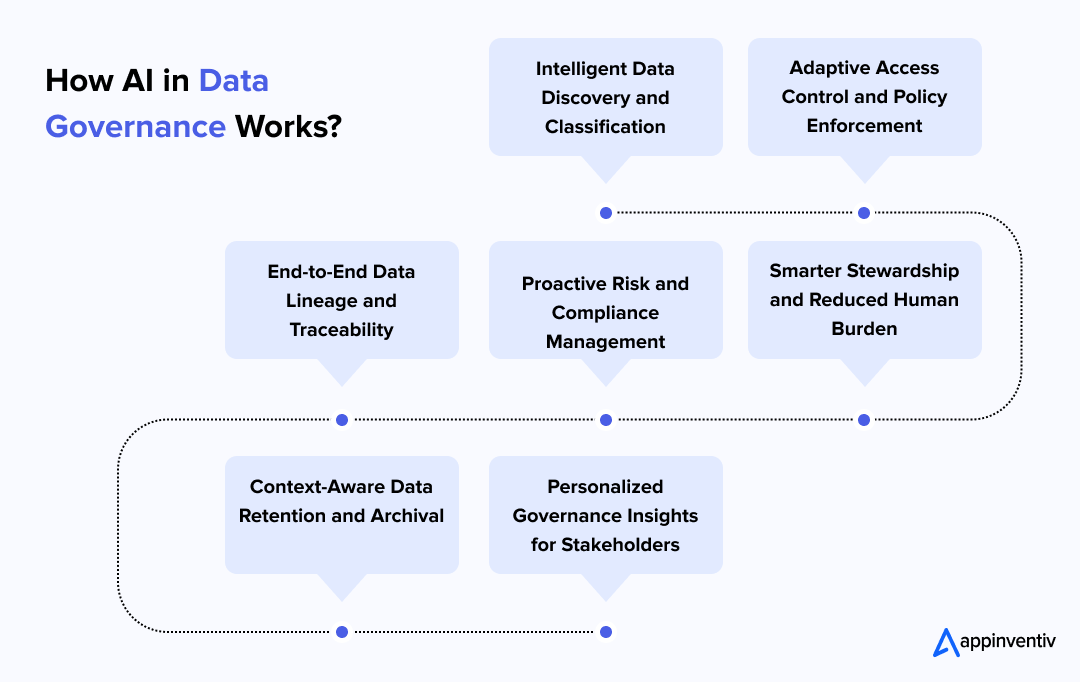
Intelligent Data Discovery and Classification
Traditional methods of data classification depend heavily on predefined rules or manual tagging, which break down when data volumes increase or when datasets are unstructured. AI in data governance models, especially those trained on natural language processing and semantic pattern recognition, can automatically scan and interpret vast troves of data to identify what’s sensitive, regulated, or business-critical.
This AI in data center operations enables governance teams to discover dark data, categorize it based on real context (not just metadata), and dynamically update classifications as data changes over time, which is crucial for keeping up with evolving regulatory standards such as HIPAA or GDPR.
Adaptive Access Control and Policy Enforcement
In most enterprises, static access control models are a leading source of friction. AI for data quality management addresses this by learning from access patterns, contextual behavior, and user roles to fine-tune governance in real time.
For instance, if a finance analyst in New York suddenly attempts to access R&D datasets from an unknown device, AI-driven data governance can detect the anomaly and either block access, flag it for review, or trigger additional multi-factor authentication systems, all without human intervention. This level of adaptiveness helps enforce least-privilege access models at scale, protecting sensitive data while maintaining productivity for users across departments and geographies.
End-to-End Data Lineage and Traceability
Knowing where your data comes from, how it has been transformed, and where it’s being consumed is foundational to governance. Still, it’s nearly impossible to track manually at an enterprise scale.
AI and data governance lineage tools can automatically map data flows across platforms, pipelines, and teams. They detect schema changes, transformations, and data joins, providing governance teams with a dynamic blueprint of how information flows.
This visibility helps accelerate impact analysis during audits, supports faster root-cause investigations when issues arise, and enables confident reporting on data compliance and quality.
Proactive Risk and Compliance Management
AI can continuously monitor governance metrics across the enterprise, identify anomalies, and learn from historical incidents to forecast compliance risks before they become material issues. Whether it’s an emerging data privacy regulation, a pattern of near-violations, or changes in third-party data usage, AI-driven data governance models can correlate signals and generate early warnings.
The predictive capability role of AI in enterprise data governance shifts compliance from a reactive posture to a proactive one, giving enterprises a head start on policy adjustments, enforcement, and documentation.
Bonus Read: Compliance Management Software Development: Benefits, Use Cases, Process, and Costs
Smarter Stewardship and Reduced Human Burden
Rather than relying on large stewardship teams to enforce governance manually, AI systems assist stewards by recommending policies, automatically resolving data quality issues, and providing decision support. For example, when duplicate records are detected across systems, AI and data governance tools can suggest canonical entries, evaluate quality scores, and automate the merging process, saving time and improving reliability.
This augmentation allows data governance teams to focus on high-value oversight rather than routine operational tasks, while ensuring greater consistency across the enterprise.
Context-Aware Data Retention and Archival
Most enterprises follow blanket retention policies that treat all data equally, resulting in bloated storage, compliance risks, and inefficient retrieval. AI for data quality management introduces context into retention decisions by analyzing data usage frequency, downstream dependencies, and compliance sensitivity.
For instance, operational data sets that are no longer referenced in analytics or decision workflows can be marked for archival, while customer interaction logs still linked to product iterations may be retained for a longer period. This data governance for AI models enables a more intelligent, risk-aware approach to data lifecycle management.
Personalized Governance Insights for Stakeholders
Governance dashboards often overwhelm users with one-size-fits-all metrics, burying what matters to decision-makers. AI in data governance models can segment alerts and insights based on user roles – surfacing schema change alerts to data architects, access anomalies to security leads, or compliance gaps to legal stakeholders.
This role-based customization not only improves clarity and response times but also fosters stronger ownership and faster corrective action across departments.
How Your Business Could Be Using AI for Data Governance?
Whether you’re operating with enterprise-wide data lakes, managing lean analytics workflows, or just setting your data foundation, Data governance for AI can adapt to your business maturity and model. Here’s how it could shape your data strategy across different business sizes:
Enterprises: Governing Complex, High-Stakes Data Environments
Picture a large, multinational healthcare provider managing patient records, clinical trial data, and insurance claims across disparate systems. With AI and data governance, they could intelligently classify and encrypt PHI, adapt policies by region (e.g., HIPAA vs. GDPR), and use behavioral AI to detect and respond to anomalous data access – all automatically.
Beyond that, implementing AI in data governance on an enterprise level could also:
- Map and visualize data lineage across internal and third-party systems for faster impact analysis.
- Automate policy rollout across hundreds of apps with minimal manual intervention.
- Predict compliance risk exposure before audits, using AI models trained on historical violations.
- Support M&A activity by quickly evaluating the data governance posture of acquired entities.
Bonus Read: How to Build an Intelligent AI Model: An Enterprise Guide
SMBs: Making Governance Lightweight but Effective
Imagine a growing B2B SaaS company with customer data spread across a CRM, marketing tools, and product analytics for business. With AI, they can implement automated tagging of PII, detect shadow IT systems that ingest sensitive data, and dynamically recommend access levels for new hires—all with minimal overhead and governance staffing.
Other ways SMBs could use AI in data governance:
- Auto-suggest retention and archival policies based on data usage and legal hold patterns.
- While implementing AI in data governance, monitor third-party integrations for compliance gaps or risky behavior.
- Reduce manual audit prep time by generating real-time compliance dashboards.
- Trigger alerts when usage patterns suggest a policy drift or unauthorized use.
Startups: Embedding Governance From the Ground Up
Now, consider a pre-series A medtech startup developing an AI-powered medical diagnostic app. Even in early product development, they can utilize AI and data governance to identify sensitive user-generated data, enforce tiered access controls among development and clinical teams, and automatically enforce encryption on specific data types – all while iterating quickly.
Additional possibilities for startups include:
- Automating security tagging across AWS buckets, databases, and file stores.
- Using AI to flag GDPR-relevant data before expansion into the EU market.
- Tracking consent data and aligning it with usage in downstream analytics.
- Setting up real-time alerts for data exfiltration or unusual admin behavior.
Preparing for AI Data Governance
AI governance doesn’t begin with tools; it starts with how your organization prepares its data, roles, and oversight structure. Here’s how enterprise teams can practically lay the foundation for AI data governance best practices:
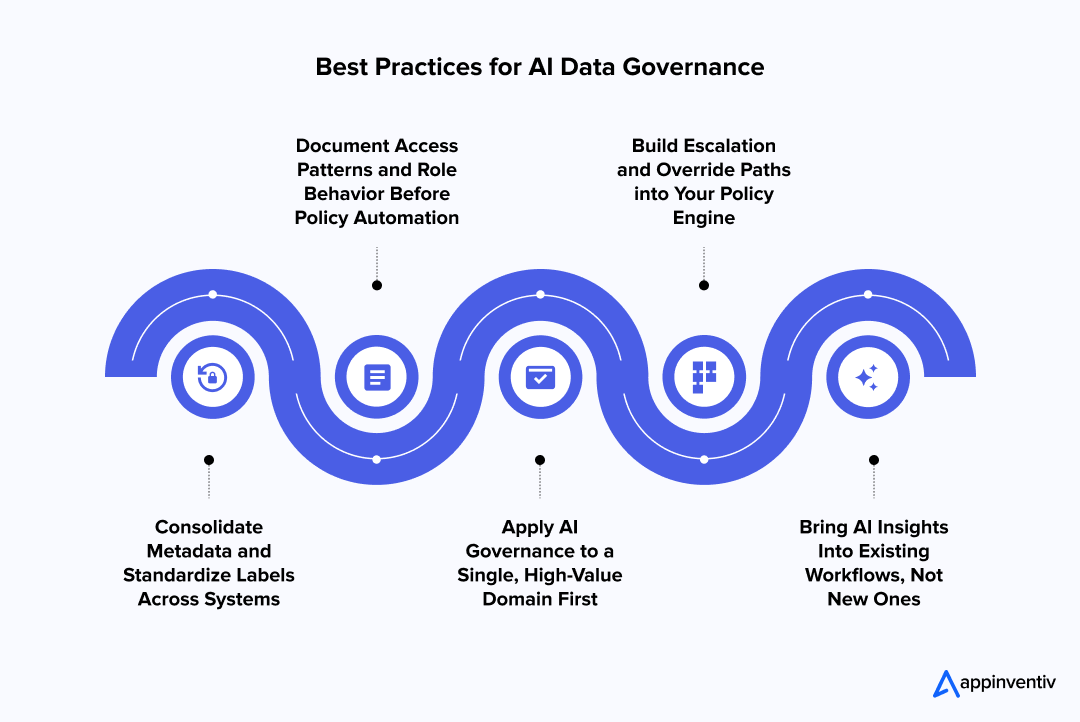
Consolidate Metadata and Standardize Labels Across Systems
If your AI model is expected to identify sensitive data or apply access rules, it needs consistency. That means aligning the labeling of fields across your CRM, ERP, and data warehouse environments.
For instance, if one system refers to “Client_Name” and another uses “CustomerFullName,” the AI and data governance merging tool won’t treat them as equivalent unless you harmonize the schema in advance.
Bonus Read: ERP Software Integration: A Complete Guide
Document Access Patterns and Role Behavior Before Policy Automation
The next AI data governance best practice is to build on the idea that automated policy enforcement works best when it reflects real-world behavior. Review which teams access which datasets, how frequently, and under what conditions.
For example, if your marketing team only pulls anonymized leads during quarterly campaigns, that pattern should inform AI-driven access models and alert thresholds.
Apply AI Governance to a Single, High-Value Domain First
Rolling out across the enterprise is tempting—but risky. Instead, start with a domain where data sensitivity is high and use cases are narrow. Let’s say you begin implementing AI in data governance with finance, using the technology to monitor anomalies in invoice records or enforce field-level encryption across payment logs.
This approach is measurable, manageable, and impactful. That early success can then be scaled to other domains, such as HR, product, or legal.
Build Escalation and Override Paths into Your Policy Engine
Machine learning for data governance isn’t infallible; edge cases will surface. You’ll need pre-defined routes for humans to step in. If the system flags access to a sensitive dataset by a senior finance lead during audit season, your stewards need the authority and visibility to approve it with context, rather than having to fight the system.
Bring AI Insights Into Existing Workflows, Not New Ones
Another crucial AI data governance best practice to follow is to embed AI insights where your teams already work, rather than forcing them to check a new dashboard. For instance, send data access alerts into Slack, pipe schema change warnings into Jira, or surface policy drift in your GRC platform. Frictionless adoption is the fastest path to trust.
How to Implement AI Data Governance the Right Way
While the AI data governance best practices can bring precision, scale, and adaptability to an enterprise, only if implementation is planned with care. Successful adoption depends on aligning your data maturity, tech stack, and compliance needs before expecting any ROI from AI models. Below are key steps that move beyond theory and into execution.

Begin with a Deep Data Discovery and Classification Initiative
Implementation starts with clarity: what data you hold, where it resides, and how it’s accessed. Most enterprises underestimate the degree of data fragmentation across their cloud platforms, including AWS, Azure, and Google Cloud, as well as legacy systems and third-party applications. Use automated crawlers to run data discovery, but don’t rely on them blindly. Manually review flagged categories to refine sensitivity tags and schema labels, especially for industry-specific data like EMR fields, legal contracts, or biometric logs.
Takeaway: The quality of tagging directly impacts model reliability. Ambiguous fields, such as “ID” or “Notes,” should be standardized before AI for data governance in enterprise models is introduced.
Choose AI Governance Tools Based on Explainability, Not Hype
The goal isn’t just automation, but trustworthy automation. Opt for tools that allow fine-grained configuration of risk scores, flag anomalies based on usage behavior (not just policy violation), and provide human-readable justifications for each enforcement or recommendation. Avoid solutions that make it hard to intervene or retrain the model, especially if you’re in a regulated space like finance, insurance, or healthcare.
Things to avoid: Governance tools that push a black-box approach with no override paths, or those that require data centralization just to function.
Align AI Governance with a Specific Business Objective
Don’t treat AI for data governance in enterprises as an IT project. Tie it to a measurable business goal, such as faster vendor onboarding, real-time fraud detection, or quicker audit resolution. This makes it easier to define your KPIs, monitor impact, and drive stakeholder buy-in.
For instance, if your objective is reducing third-party data access risks, use AI to analyze historical access logs, recommend least-privilege policies, and flag excessive entitlements in real time.
Build the Right Review and Override Workflows
AI will get it wrong sometimes, and when it does, you need people who can act. Set up role-based overrides for flagged access, schema changes, or policy violations. Train data stewards to review alerts not just technically, but in terms of context. Also, don’t forget to make version changes so every override feeds back into model refinement.
Here’s a quick checklist to keep everything in control:
- Who approves override requests?
- How are false positives handled?
- Where are overrides logged and reviewed?
Pilot in a Contained Environment, Then Scale
Start small – pick a business domain like marketing, procurement, or finance, and deploy AI governance only for that unit. Measure adoption rates, model precision, false positives, and resolution time. Only after you’ve validated the workflow and outcomes should you replicate across other units or data types.
Good early candidates: Expense data, vendor access logs, fintech or payment APIs, or shared drives with multi-department usage.
Invest in Internal Literacy and Governance Culture
Even the best AI system underperforms in a low-awareness environment. Equip your data teams, analysts, and decision-makers with the foundational understanding of AI’s role in governance – what it does, what it doesn’t, and when to intervene. From short training modules to cross-functional workshops, this literacy layer closes the loop between automation and accountability.
Takeaway: A model is only as effective as the culture in which it’s embedded. Technical success requires behavioral readiness.
Challenges and Ethical Considerations in Machine Learning for Data Governance
As AI increasingly becomes a core component of data governance frameworks, enterprises find themselves at the intersection of innovation and accountability. While automation enhances efficiency and scale, it also introduces a new layer of risk, one that isn’t purely technical.
Bias in AI Models
- Challenge: The primary concern for AI for data governance in enterprises is bias in AI models. AI learns from historical data, often embedding human or institutional biases. Automated policies can skew access, penalize outliers, or miss exceptions, thereby amplifying past inefficiencies.
- Solutions:
- Audit training data regularly to identify and mitigate biases.
- Implement fairness-aware algorithms and conduct bias impact assessments.
- Design flexible policies that account for outliers and exceptions.
- Continuously update models to correct inefficiencies and align with equitable outcomes.
Lack of Explainability
- Challenge: Explainability is another critical challenge of using AI in data governance. The “black box” nature of AI undermines trust among stakeholders; unclear decisions regarding access grants, revocations, or flags lead to pushback, which increases legal exposure during audits and slows AI adoption.
- Solutions:
- Utilize interpretable AI models or provide detailed decision logs to ensure transparency.
- Develop clear, stakeholder-facing explanations of AI-driven decisions to ensure transparency and accountability.
- Maintain audit-ready documentation to ensure compliance and traceability.
- Train teams on AI processes to foster trust and adoption.
Privacy Concerns
- Challenge: AI monitoring of user behavior or queries can create a surveillance culture, posing a risk of non-compliance with data protection laws (e.g., EU, California), and necessitating a balance between observability and ethical and legal boundaries.
- Solutions:
- Limit data collection to essential metrics and anonymize sensitive information.
- Align AI systems with regional data protection laws (e.g., GDPR, CCPA).
- Implement privacy-by-design principles to minimize intrusive monitoring.
- Communicate privacy policies to avoid perceptions of surveillance.
Illusion of Infallibility
- Challenge: Perhaps one of the most overlooked challenges of using AI in data governance is the illusion of infallibility. AI appears intelligent but can fail in edge cases (e.g., legal discovery, healthcare, audits); lack of human oversight escalates errors; unclear ownership hinders accountability.
- Solutions:
- Integrate human-in-the-loop oversight for high-stakes decisions.
- Establish clear protocols for detecting and escalating errors.
- Define roles and responsibilities for AI system management and accountability.
- Monitor edge cases through regular stress testing and validation.
Ethical Pitfalls
- Challenge: The reality is that AI in enterprise data management isn’t immune to ethical pitfalls; in many ways, it demands more governance, not less. AI demands more governance to avoid amplifying risks; it requires humility, cross-functional collaboration, and transparency. Success hinges on mature processes and a responsible data culture.
- Solutions:
- Form cross-functional teams to oversee AI governance and ensure diverse perspectives.
- Embed transparency and ethical guidelines in AI development and deployment.
- Foster a culture of responsible data use through training and leadership commitment.
- Regularly review and refine governance processes to align with ethical standards.
Enterprises must approach implementation with humility, cross-functional participation, and a commitment to transparency. Getting it right requires not just great tech, but mature processes and an internal culture that values responsible data use.
The Future of AI Data Governance
AI is rapidly transforming data governance into a dynamic, autonomous, and intelligence-driven capability—one that can respond to the scale, complexity, and compliance expectations of modern enterprises. Below are the key directions in which AI in enterprise data management is headed next, backed by real technological advancements and enterprise needs.
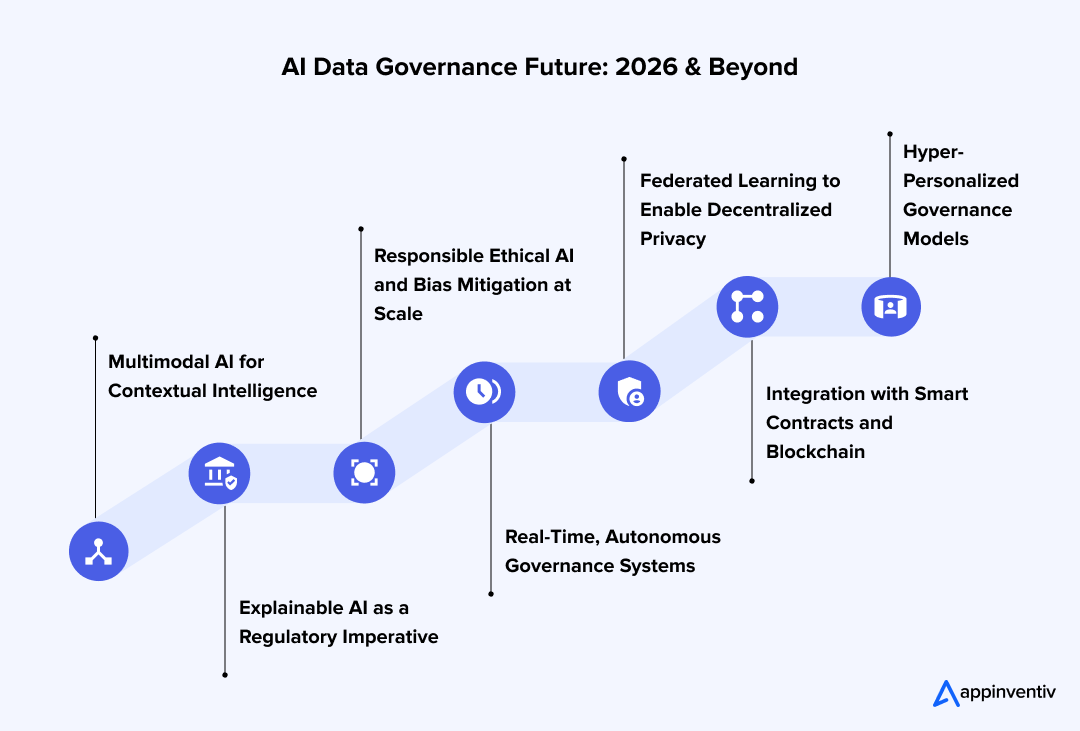
1. Multimodal AI for Contextual Intelligence
Future data governance systems won’t be restricted to structured data or static rules. Multimodal AI will enable enterprises to manage data across various formats, including text, audio, video, biometrics, device behavior, and more.
These models can analyze unstructured physician notes, patient scans, customer call transcripts, or even usage telemetry to make context-aware governance decisions.
For instance, in healthcare, a multimodal system could detect that a voice note from a physician contains PHI, classify it accordingly, and restrict sharing outside the EMR system—all without human intervention. This kind of rich context enables more accurate classification, better access control, and fewer false positives, particularly in regulated environments where data isn’t always clean or structured.
Bonus Read: EMR Integration in Healthcare: Benefits, Features, & Costs
2. Explainable AI as a Regulatory Imperative
As AI in enterprise data management assumes greater responsibility in decision-making, regulators and auditors will demand more than accuracy; they’ll require transparency.
Explainable AI (XAI) in data governance enables enterprises to trace every automated decision—why access was denied, why data was labeled as sensitive, or why a risk flag was raised.
This is particularly crucial for industries such as banking, pharmaceuticals, and insurance, where governance errors can result in regulatory penalties. Future tools will not only show results but also narrate decision trees, training logic, and model behavior in human-readable language. This makes it easier to defend audits, identify model flaws, and build stakeholder trust across departments and legal teams.
3. Responsible Ethical AI and Bias Mitigation at Scale
Without checks, AI models can perpetuate historical biases, particularly in governance areas such as vendor scoring, data access, or policy enforcement. For example, if past user activity data was skewed toward one region or demographic, an AI model may recommend disproportionate access restrictions elsewhere.
Future governance platforms will incorporate bias detection modules that monitor AI behavior across diverse populations and recommend targeted fairness interventions. This might include alerting when access policies disproportionately impact specific user roles, flagging training data gaps, or prompting human review before sensitive decisions. Responsible Ethical AI ensures governance models are not only intelligent but also just and representative.
4. Real-Time, Autonomous Governance Systems
The pace of enterprise operations necessitates governance decisions that occur in real-time. AI is making this possible through always-on monitoring and dynamic enforcement. Instead of waiting for weekly audits or manual triage, AI can monitor data flow in real-time, detect anomalies (such as access from an unusual IP or schema changes in sensitive tables), and take immediate action—blocking, flagging, or quarantining the incident.
Autonomous governance also means systems that evolve continuously, learning from user feedback, identifying and overriding patterns, and adapting to new regulations. This self-adjusting behavior helps enterprises maintain agility and compliance without constantly rewriting rules or relying on overstretched data teams.
5. Federated Learning to Enable Decentralized Privacy
A major hurdle in AI-based governance is the need for large-scale, diverse data to train reliable models. However, enterprises are often unwilling, or legally unable, to centralize sensitive data from across divisions, geographies, or partner networks. Federated learning solves this by enabling AI models to train locally and share only the learnings, not the data itself.
This approach is especially useful in industries such as healthcare, where patient data from across hospitals can inform better governance models, but cannot be legally shared. Federated learning enables collaboration while preserving data privacy, facilitating smarter governance without compromising compliance boundaries.
6. Integration with Smart Contracts and Blockchain
In the future, AI governance decisions won’t just stop at enforcement – they’ll trigger automated, traceable workflows. For example, if an AI model flags non-compliant data access, it could invoke a smart contract to notify the user, revoke access, update an immutable log, and alert compliance – all in milliseconds.
Blockchain adds a layer of auditability and trust, particularly in complex multi-organization environments such as pharmaceutical supply chains or global financial networks. Combined with AI, this makes governance not just smarter, but also more legally defensible and collaboration-ready.
7. Hyper-Personalized Governance Models
Lastly, as enterprises scale and diversify, one-size-fits-all governance breaks down. The next generation of AI tools will support personalized governance policies that adapt to each business unit, department, or user segment. For example, data scientists may need high-volume access to raw datasets, while finance teams may require tighter controls but more flexibility in third-party tools.
AI in data protection and governance will learn these operational contexts and adjust governance logic accordingly, allowing policies that are customized, risk-aware, and productivity-friendly. This unlocks agility while maintaining control, a balance that traditional governance models have long struggled to achieve.
Why Appinventiv is Your Strategic Partner for AI-Powered Data Governance?
Enterprises don’t just need AI tools – they need a governance partner who understands the full lifecycle of data, the realities of enterprise infrastructure, and the regulatory pressures that come with scale. That’s where Appinventiv’s AI development services come in. Our approach to AI data governance is built from the ground up to align with your business, compliance, and growth goals.
- We begin with an in-depth discovery of your existing data estate, uncovering fragmentation across cloud, hybrid, and legacy environments. From there, we design governance frameworks that are powered by custom-trained AI models, which are explainable, scalable, and context-aware.
- Every model we deploy is tailored to your access policies, data classification standards, and risk thresholds. That means no black boxes, no plug-and-play shortcuts – just reliable automation you can trust.
- We treat compliance as a core principle in our architecture when building an AI-driven data governance framework. Whether you operate in healthcare, finance, retail, or logistics, we build systems that support HIPAA, GDPR, SOC 2, and other regulatory frameworks natively, complete with audit trails, override controls, and role-based workflows.
Finally, we don’t stop at implementation. Our AI services and solutions teams provide continuous monitoring, performance optimization, and roadmap alignment to ensure that your governance system evolves in tandem with your data and business. From policy automation to real-time risk detection, Appinventiv helps you make AI a competitive asset, not a compliance liability.
FAQs
Q. How is AI transforming data governance?
A. AI is turning data governance from a static rules-based framework into a dynamic, self-adaptive system. It automates data classification, detects anomalies in access patterns, and provides real-time policy enforcement. With AI, governance becomes continuous and predictive – capable of handling the velocity and variety of modern enterprise data without manual intervention.
Q. How to implement AI in data governance?
A. Start with a deep audit of your data landscape: identify what data you hold, where it resides, and who accesses it. From there, define AI-based data governance automation goals (e.g. faster audit readiness, reduced access risks) and select AI tools that align with them. Focus on explainability, integration with your stack, and override mechanisms. Pilot the system in a contained business unit before scaling enterprise-wide.
Q. How does AI help enterprises manage data governance?
A. AI assists enterprises by automating repetitive governance tasks like tagging, risk scoring, and compliance checks. It learns from past decisions to flag potential policy violations and adapts controls in real time based on behavior. This reduces the human workload while making governance systems more responsive and less error-prone.
Q. How does AI enhance data governance?
A. When investing in building an AI-driven data governance framework the entrepreneurs expect it to enhance governance by adding intelligence and context. Instead of applying static rules blindly, AI looks at patterns – who’s accessing what, when, and how to make informed decisions. It can flag anomalies, recommend access changes, suggest policy improvements, and give enterprises visibility into data flows that were previously dark or undocumented.
Product Development & Engineering
IT Managed & Outsourcing
Consulting Services
Data Services
Didn't find what you're looking for? Let us know your needs, and we'll tailor a solution just for you.




